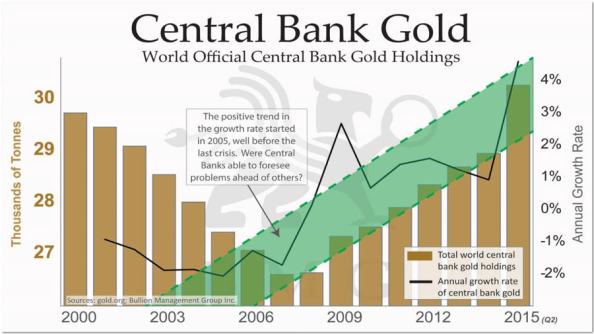These are not normal economic times.
Interest rates have remained artificially low, plunging into negative territory in many places. Central banks continue to inflate the money supply with quantitative easing. Some policy-makers have even floated the idea of helicopter money. Worldwide money printing is reportedly approaching $100 trillion.
There is no end to this crazy monetary policy in sight. This led billionaire investor Stanley Druckenmiller to recommend selling US stocks to buy gold. Well-known hedge fund manager Paul Singer said the recent surge in gold is just the beginning. And Bank of America said gold is entering a new and long bull market.

Ironically, their own policies are driving some some central bankers to do what they generally scorn – buy gold. In fact, many central banks are piling into the yellow metal.
Overall demand for gold continues to surge, hitting 1,290 tons in the first quarter of this year. It was the second-largest quarterly demand spike on record. Investors have led the charge. According to data gathered by Bloomberg, holdings of the yellow metal in exchange traded funds have increased to 1,823.3 tons, the most since December 2013. In just the past two week, ETF gold holdings swelled 63.2 tons.
Why?
As Bloomberg put it, investors are buying gold due to “rising concern about central bank policy-making worldwide.” Bernard Aw, a strategist at IG Asia Pte, also pointed to central bank policies as a prime driver of the surging gold market.
Firstly, the negative interest rate environment and quantitative-easing policies are reducing the pool of suitable investment options, and making gold less costly to hold. Second, lingering fears of competitive currency devaluations and potentially fresh bouts of market volatility encourage safe-haven demand.”
Even while continuing to implement policies driving gold demand skyward, central banks themselves are buying gold, with China, Russia, and Kazakhstan leading the pack. According to the World Gold Council, central banks added 109 tons to their reserves in the first quarter of this year. It was the 21stconsecutive month central banks have been net purchasers of gold. Central banks accounted for about 14% of the world’s gold demand last year. Gold purchases by central banks have moved from less than 2% of world demand for gold in 2009 to over 14% in 2015.









Leave A Comment